Heritage railway
This article needs additional citations for verification. (June 2021) |
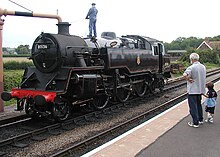

A heritage railway or heritage railroad (US usage) is a railway operated as living history to re-create or preserve railway scenes of the past. Heritage railways are often old railway lines preserved in a state depicting a period (or periods) in the history of rail transport.
Definition[]
The British Office of Rail and Road defines heritage railways as follows:[1]
...'lines of local interest', museum railways or tourist railways that have retained or assumed the character and appearance and operating practices of railways of former times. Several lines that operate in isolation provide genuine transport facilities, providing community links. Most lines constitute tourist or educational attractions in their own right. Much of the rolling stock and other equipment used on these systems is original and is of historic value in its own right. Many systems aim to replicate both the look and operating practices of historic former railways companies.
Infrastructure[]
Heritage railway lines have historic rail infrastructure which has been substituted (or made obsolete) in modern rail systems. Historical installations, such as hand-operated points, water cranes, and rails fastened with hand-hammered rail spikes, are characteristic features of heritage lines. Unlike tourist railways, which primarily carry tourists and have modern installations and vehicles, heritage-line infrastructure creates views and soundscapes of the past in operation.
Operation[]
Due to a lack of modern technology or the desire for historical accuracy, railway operations can be handled with traditional practices such as the use of tokens. Heritage infrastructure and operations often require the assignment of roles, based on historical occupations, to the railway staff. Some, or all, staff and volunteers, including Station masters and signalmen, sometimes wearing period-appropriate attire, can be seen on some heritage railways. Most heritage railways use heritage rolling stock, although modern rail vehicles can be used to showcase railway scenes with historical-line infrastructure.
Cost[]
While some heritage railways are profitable tourist attractions, many are not-for-profit entities; some of the latter depend on enthusiastic volunteers for upkeep and operations to supplement revenue from traffic and visitors. Still other heritage railways offer a viable public-transit option, and can maintain operations with revenue from regular riders or government subsidies.
Development[]
Children's railways[]

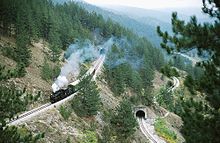


Children's railways are extracurricular educational institutions where children and teenagers learn about railway work; they are often functional, passenger-carrying narrow-gauge rail lines. The railways developed in the USSR during the Soviet era. Many were called "Pioneer railways", after the youth organisation of that name. The first children's railway opened in Moscow[2] in 1932 and, at the breakup of the USSR, 52 children's railways existed in the country.[3] Although the fall of communist governments has led to the closure of some, preserved children's railways are still functioning in post-Soviet states and Eastern European countries.
Many children's railways were built on parkland in urban areas. Unlike many industrial areas typically served by a narrow-gauge railway, parks were free of redevelopment. Child volunteers and socialist fiscal policy enabled the existence of many of these railways. Children's railways which still carry traffic have often retained their original infrastructure and rolling stock, including vintage steam locomotives;[4][5] some have acquired heritage vehicles from other railways.
Examples of children's railways with steam locomotives include the Dresden Park Railway in Germany; the Gyermekvasút in Budapest; the Park Railway Maltanka in Poznań; the Košice Children's Railway in Slovakia, and the 7+1⁄4 in (184 mm) gauge steam railway on the grounds of St Nicholas' School in Merstham, Surrey, which the children help operate with assistance from the East Surrey 16mm Group and other volunteers.[6][7]
Mountain railways[]
Creating passages for trains up steep hills and through mountain regions offers many obstacles which call for technical solutions. Steep grade railway technologies and extensive tunneling may be employed. The use of narrow gauge allows tighter curves in the track, and offers a smaller structure gauge and tunnel size. At high altitudes, construction and logistical difficulties, limited urban development and demand for transport and special rolling-stock requirements have left many mountain railways unmodernized. The engineering feats of past railway builders and views of pristine mountain scenes have made many railways in mountainous areas profitable tourist attractions.
Pit railways[]
Pit railways have been in operation in underground mines all over the world. Small rail vehicles transport ore, waste rock, and workers through narrow tunnels. Sometimes trains were the sole mode of transport in the passages between the work sites and the mine entrance. The railway's loading gauge often dictated the cross-section of passages to be dug. At many mining sites, pit railways have been abandoned due to mine closure or adoption of new transportation equipment. Some show mines have a vintage pit railway and offer mantrip rides into the mine.
Underground railways[]
The Metro 1 (officially the Millennium Underground Railway or M1), built from 1894 to 1896, is the oldest line of the Budapest Metro system and the second-oldest underground railway in the world.[8] The M1 underwent major reconstruction during the 1980s and 1990s, and Line 1 now serves eight original stations whose original appearance has been preserved. In 2002, the line was listed as a UNESCO World Heritage Site.[9] In the Deák Ferenc Square concourse's Millennium Underground Museum, many other artifacts of the metro's early history may be seen.
Around the world[]
The first heritage railway to be rescued and run entirely by volunteers was the Talyllyn Railway in Wales. This narrow-gauge line, taken over by a group of enthusiasts in 1950, was the beginning of the preservation movement worldwide.
Argentina[]

La Trochita (officially Viejo Expreso Patagónico, the Old Patagonian Express) was declared a National Historic Monument by the Government of Argentina in 1999.[10] Trains on the Patagonian 750 mm (2 ft 5+1⁄2 in) narrow-gauge railway use steam locomotives. The 402-kilometre-long (250 mi) railway runs through the foothills of the Andes between Esquel and El Maitén in Chubut Province and Ingeniero Jacobacci in Río Negro Province.
In southern Argentina, the Train of the End of the World to the Tierra del Fuego National Park is considered the world's southernmost functioning railway. Heritage railway operations started in 1994, after restoration of the old 500 mm (19+3⁄4 in) (narrow-gauge) steam railway.
In Salta Province in northeastern Argentina, the Tren a las Nubes (Train to the Clouds) runs along 220 km (140 mi) of 1,000 mm (3 ft 3+3⁄8 in) metre gauge track in what is one of the highest railways in the world. The line has 29 bridges, 21 tunnels, 13 viaducts, two spirals and two zigzags, and its highest point is 4,220 metres (13,850 ft) above sea level.
In the Misiones Province, more precisely in the Iguazú National Park, is the Ecological Train of the Forest. With a speed below 20 km per hour to avoid interfering with wildlife and the formations are propelled to liquefied petroleum gas (LPG), a non-polluting fuel.[11]
The Villa Elisa Historic Train (operated by Ferroclub Central Entrerriano) runs steam trains between the cities of Villa Elisa and Caseros in Entre Ríos Province, covering 36 km (22 mi)[12] in 120 minutes.[13]
Australia[]
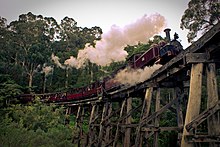
The world's second most preserved railway, and the first outside the United Kingdom, was Australia's Puffing Billy Railway. This railway operates on 15 miles (24 km) of track, with much of its original rolling stock built as early as 1898. Just about over half of Australia's heritage lines are operated by narrow gauge tank engines, much like the narrow gauge lines of the United Kingdom.
Belgium[]
Flanders, Belgium's northern Dutch-speaking region, has the Dendermonde–Puurs Steam Railway; whereas Wallonia, with its strong history of 19th century heavy industries, has the Chemin de fer à vapeur des Trois Vallées and PFT operates the Chemin de Fer du Bocq.
Canada[]
Finland[]
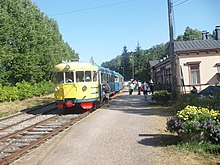
On the Finnish state-owned rail network, the section between Olli and Porvoo is a dedicated museum line. In southern Finland, it is the only line with many structural details abandoned by the rest of the network which regularly carries passenger traffic. Wooden sleepers, gravel ballast and low rail weight with no overhead catenary make it uniquely historical.[14] Along the line, the Hinthaara railway station and the Porvoo railway station area are included in the National Board of Antiquities' inventory of cultural environments of national significance in Finland. Also on the list is scenery in the Porvoonjoki Valley, through which the line passes.[15]
The Jokioinen Museum Railway is a stretch of preserved narrow-gauge railway between Humppila and Jokioinen. Nykarleby Järnväg is a stretch of rebuilt narrow-gauge railway on the bank of the old Kovjoki–Nykarleby line.[16]
India[]

Of the mountain railways of India, the Darjeeling Himalayan, Nilgiri Mountain and Kalka–Shimla Railways have been collectively designated as a UNESCO World Heritage Site.[17][18][19] To meet World Heritage criteria, the sites must retain some of their traditional infrastructure and culture.
Slovakia[]
The Čierny Hron Railway is a narrow-gauge railway in central Slovakia, established in the first decade of the 20th century and operating primarily as a freight railway for the local logging industry. From the late 1920s to the early 1960s, it also offered passenger transport between the villages of Hronec and Čierny Balog. The railway became Czechoslovakia's most extensive forest railway network. After its closure in 1982, it received heritage status and was restored during the following decade. Since 1992, it has been one of Slovakia's official heritage railways and is a key regional tourist attraction. The Historical Logging Switchback Railway in Vychylovka is a heritage railway in north-central Slovakia, originally built to serve the logging industry in the Orava and Kysuce regions. Despite a closure and dissasembly of most of its original network during the early 1970s, its surviving lines and branches have been (or are being) restored. The railway is owned and operated by the Museum of Kysuce, with a 3.8-kilometre (2.4 mi) line open to tourists for sightseeing.
Switzerland[]

Switzerland has a very dense rail network, both standard and narrow gauge. The overwhelming majority of railways, built between the mid-19th and early 20th century, are still in regular operation today and electrified, a major exception being the Furka Steam Railway, the longest unelectrified line in the country and one of the highest rail crossings in Europe. Many railway companies, especially mountain railways, provide services with well-preserved historic trains for tourists, for instance the Rigi Railways, the oldest rack railway in Europe, and the Pilatus Railway, the steepest in the world. Two railways, the Albula Railway and the Bernina Railway, have been designated as a World Heritage Site, although they are essentially operated with modern rolling stock. Due to the availability of hydroelectric resources in the Alps, the Swiss network was electrified earlier than in the rest of Europe.[20] Some of the most emblematic pre-World War II electric locomotives and trains are the Crocodile, notably used on the Gotthard Railway,[21] and the Red Arrow. Both are occasionally operated by SBB Historic. Switzerland also comprehends a large number of funiculars, several still working with the original carriages, such as the Giessbachbahn.
United Kingdom[]
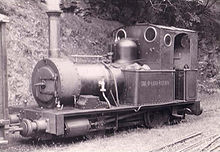
In Britain, heritage railways are often railway lines which were run as commercial railways but were no longer needed (or closed down) and were taken over or re-opened by volunteers or non-profit organisations. The large number of heritage railways in the UK is due in part to the closure of many minor lines during the 1960s' Beeching cuts, and they were relatively easy to revive. There are between 100 and 150 heritage railways in the United Kingdom.
A typical British heritage railway will use steam locomotives and original rolling stock to create a period atmosphere, although some are concentrating on diesel and electric traction to re-create the post-steam era. Many run seasonally on partial routes, unconnected to a larger network (or railway), and charge high fares in comparison with transit services; as a result, they focus on the tourist and leisure markets. During the 1990s and 2000s, however, some heritage railways aimed to provide local transportation and extend their running seasons to carry commercial passenger traffic.

The first standard-gauge line to be preserved (not a victim of Beeching) was the Middleton Railway; the second, and the first to carry passengers, was the Bluebell Railway.
Not-for-profit heritage railways differ in their quantity of service and some lines see traffic only on summer weekends. The more successful, such as the Severn Valley Railway and the North Yorkshire Moors Railway, may have up to five or six steam locomotives and operate a four-train service daily; smaller railways may run daily throughout the summer with only one steam locomotive. The Great Central Railway, the only preserved British main line with a double track, can operate over 50 trains on a busy timetable day.
After the privatisation of main-line railways, the line between not-for-profit heritage railways and for-profit branch lines may be blurred. The Romney, Hythe and Dymchurch Railway is an example of a commercial line run as a heritage operation and to provide local transportation, and the Severn Valley Railway has operated a few goods trains commercially. A number of heritage railway lines are regularly used by commercial freight operators.
Since the Bluebell Railway reopened to traffic in 1960, the definition of private standard gauge railways in the United Kingdom as preserved railways has evolved as the number of projects and their length, operating days and function have changed. The situation is further muddied by large variations in ownership-company structure, rolling stock and other assets. Unlike community railways, tourist railways in the UK are vertically integrated (although those operating mainly as charities separate their charitable and non-charitable activities for accounting purposes).
United States[]


Heritage railways are known in the United States as tourist, historic, or scenic railroads. Most are remnants of original railroads, and some are reconstructed after having been scrapped. Some heritage railways preserve entire railroads in their original state using original structures, track, and motive power.

Examples of heritage railroads in the US by preservation type:
- Remnant
- Durango and Silverton Railroad (Colorado)
- Cumbres and Toltec Scenic Railroad (Colorado and New Mexico)
- Hocking Valley Scenic Railway (Ohio)
- Heber Valley Railroad (Utah)
- Tennessee Valley Railroad Museum (Tennessee)
- Reconstructed
- Sumpter Valley Railway (Oregon)
- Tweetsie Railroad (North Carolina)
- Virginia and Truckee Railroad (Nevada)
- Wiscasset, Waterville and Farmington Railway (Maine)
- Original
- Nevada Northern Railway (Nevada)
- Niles Canyon Railway (California)
- California Western Railroad (California)
- Delaware and Ulster Railroad (New York)
- Stewartstown Railroad (Pennsylvania)
- Strasburg Rail Road (Pennsylvania)
- National Park Related Lines
- Grand Canyon Railway (Arizona)
- Cuyahoga Valley Scenic Railroad (Ohio)
- Mount Hood Railroad (Oregon)
- Golden Spike National Historical Park (Utah)
Some do not fit in the above categories, like the Rio Grande Scenic Railroad (a subsidiary of the San Luis and Rio Grande Railroad). The SL&RG, primarily a freight operation on former Denver and Rio Grande Western Railroad track, owns and operates a steam locomotive and a fleet of passenger cars (most of which are painted in D&RGW colors). Many heritage railways host living-history events such as annual reenactments of historic activities, and may have an archive or library of railroad-related materials.
In popular culture[]
The preservation of the Talyllyn Railway was the inspiration for the 1953 Ealing Studios comedy The Titfield Thunderbolt. The film is centred on the preservation of a fictional Somerset branch line from Titfield to Mallingford. Filmed on the Camerton branch in the summer of 1952, the branch was lifted after production had finished.
Many preserved railways also served as a filming location for several production companies; for example, the Keighley and Worth Valley Railway served as a filming location for the 1970 adaptation of The Railway Children.
Series three of Survivors uses heritage railways to help reestablish transportation, communication and trade in post-apocalyptic England.[citation needed]
See also[]
References[]
- ^ "Minor and Heritage Railways". orr.gov.uk. Office of Rail and Road. Archived from the original on February 22, 2018. Retrieved August 16, 2018.
- ^ http://www.dzd-ussr.ru/towns/moscow/cpkio.html Children's railways: Gorky Park, Moscow (in Russian)
- ^ "'Children's railway' a training ground for future rail personnel". Archived from the original on 2014-11-06. Retrieved 2013-11-23.
- ^ http://www.gyermekvasut.hu/english/page.php?8 Budapest Children's railways website: Rolling Stock
- ^ http://www.visitkosice.eu/en/things-to-see-and-do/attractions/childrens-railway Archived 2013-12-03 at the Wayback Machine Košice Children's railways
- ^ http://www.worldrailfans.info/7.25inch/GalleryMersthamVRConstruction.shtml The only British children's railway that is operational in 2014
- ^ http://www.eastsurrey16mm.org.uk/ Helps keep the school's railway running, and puts on a number of steam and model train shows at that school
- ^ Kogan Page: Europe Review 2003/2004, fifth edition, Wolden Publishing Ltd, 2003, page 174 [1]
- ^ Centre, UNESCO World Heritage. "Budapest, including the Banks of the Danube, the Buda Castle Quarter and Andrássy Avenue". UNESCO World Heritage Centre.
- ^ 'El Kavanagh, entre los protegidos', Clarín, 1999-04-23 (Spanish)
- ^ https://iguazuargentina.com/es/atractivos/tren-ecologico-de-la-selva
- ^ Tren turístico de Villa Elisa Archived 2015-06-06 at the Wayback Machine on Girasol Hostería
- ^ "15 trenes turísticos de la Argentina", Clarín, 24 May 2015
- ^ http://www2.liikennevirasto.fi/julkaisut/pdf3/lv_2012-05_finnish_railway_web.pdf Finnish Railway Network Statement 2014
- ^ http://www.rky.fi/read/asp/r_kohde_list.aspx the National Board of Antiquities' inventory of built cultural environments of national significance in Finland. In Finnish
- ^ http://nykarlebyjernvag.webs.com/inenglish.htm the National Board of Antiquities' inventory of built cultural environments of national significance in Finland. In Finnish
- ^ "Mountain Railways of India". World Heritage:UNESCO. Retrieved 2010-02-19.
- ^ Kohli, M.S.; Ashwani Lohani (2004). Mountains of India: Tourism, Adventure, Pilgrimage. The Indian Mountain Railway. Indus Publishing. pp. 97–106. ISBN 81-7387-135-3. Retrieved 2010-02-20.
- ^ "Luxury Trains of India". Archived from the original on January 3, 2004. Retrieved 2010-02-20.
- ^ Electrification in German, French and Italian in the online Historical Dictionary of Switzerland.
- ^ Défilé de la «Crocodile» pour le plus grand plaisir du public, Swiss Federal Railways
External links[]
| Wikivoyage has a travel guide for Heritage railways. |
| Wikimedia Commons has media related to Heritage rail transport. |
- Heritage railways
- Engineering preservation societies